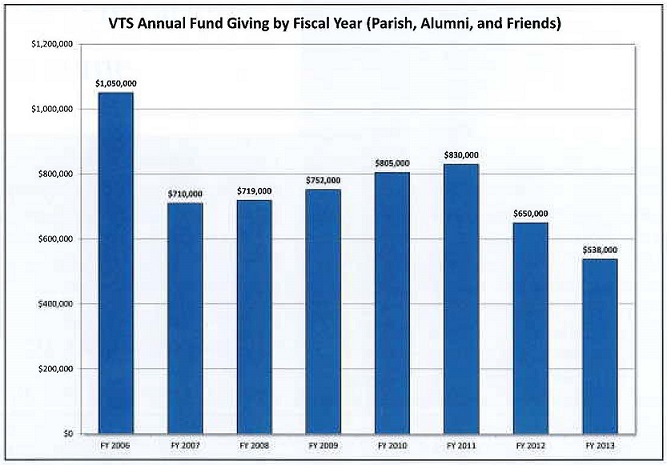Virginia Theological Seminary Dean Ian S. Markham caused a stir last year after giving a provocatively titled address at the Diocese of Delaware convention on “The Myth of the Decline of the Episcopal Church.”
Recalling that the denomination was not in a state of decline in the 1990s, Markham insisted that the Episcopal Church was primed for a turnaround after shedding hundreds of thousands of members in the 2000s. The address was met alternately with appreciation and incredulity from different corners of the Anglican/Episcopal blogosphere.
Markham has been a voice unabashedly predicting a positive future for the shrinking denomination. But now the institution Markham leads – the largest of the Episcopal Church’s 11 accredited seminaries — may itself be seeing a decline in support.
Giving to the Virginia Theological Seminary (VTS) Annual Fund has dropped dramatically in recent years. In 2006, the Alexandria, Virginia-based school received $1,050,000 from parishes, alumni and other supporters. By Fiscal Year 2013, giving to the fund had been cut nearly in half, dropping to $538,000.
VTS officials have not let the shortfall go unnoticed, with Markham making development of the Annual Fund a priority for Fiscal Year 2014.

With an endowment of nearly $140 million to draw upon, the near-term survival of VTS is not in question. Unlike financially strained Episcopal seminaries such as General Theological Seminary, Episcopal Divinity School and recently merged Bexley-Seabury, VTS has not necessitated the sale of property to reduce debt or fund operations.
VTS has continued to receive gifts in excess of $5,000 from moneyed Episcopal congregations such as St. Paul’s of Richmond, Christ Church Cathedral of Indianapolis and St. Martin’s Houston, the largest in the 1.8 million-member denomination. A handful of foundations offered $25,000 or more, alongside Trinity Wall Street in New York, the wealthiest parish in the church. Individuals, including litigator and Chancellor to the Presiding Bishop David Booth Beers, contributed in excess of $2,500 to the school last year. Still, VTS has seen funding decline sharply.
Data provided from the Association of Theological Schools shows a total 2012-2013 enrollment of 250 in VTS, with 169 full-time students taking classes — large by Episcopal standards but significantly smaller than some peers in oldline denominations.
In 2010, the seminary’s late Victorian wooden chapel was engulfed in a fire that inflicted an estimated $2.5 million in damages. The 1881 structure has been turned into a memorial garden and a new chapel is under construction.
Update – Dean Ian Markham responds: “As I understand your piece you are citing the 2012-2013 Annual Fund data as evidence of declining support for the Seminary. I am puzzled however why you didn’t take into account the Capital Campaign which was running parallel with our Annual Fund during this year. This is the season when the Seminary raised $14.4 million for our new Welcome and Worship Quad. So if gifts are your indicator of institutional strength, then surely the combined totals of Annual Fund and the Capital Campaign are indicative of deep strength.”





Comment by Rod on February 20, 2014 at 4:39 pm
Any thoughts on the 30% drop from ’06 to’07?
Comment by Jeffrey Walton on February 20, 2014 at 4:55 pm
Rod, presumably that ’06-’07 drop would be tied to the recession. As for the ’11-’13 drops, who knows? VTS did have a capital campaign to fund the new chapel, perhaps it cannibalized the Annual Fund during that time. It is also possible that the VTS donor base is growing older, or that some donors have concluded VTS is no longer sufficiently orthodox and have taken their donations elsewhere.
Comment by Dorian on February 21, 2014 at 8:58 am
VTS did have a $14.4 million capital campaign for the new chapel (it would have been appropriate to see that recognition in the article itself). The walls are going up, and the new chapel will be finished in early 2015. Since the completion of the capital campaign, we are seeing giving to the annual fund increasing significantly, so I think you are correct when you wonder if the capital campaign affected giving to the annual fund. The other dynamic to note is that the current MDiv classes are of good size and quite young. This year’s graduating class has over 40 preparing for the priesthood, and the median age is 35. The current middler class has a median age in the mid-late 20s. If the giving to the capital campaign and the dynamics of the student body are taken as indicators in the larger picture, VTS does not appear to be in any sort of decline. In fact, step on campus, and you will find a place that is vibrant, growing, and exciting.
Blessings in Christ,
D
Comment by Fr John on February 25, 2014 at 6:10 pm
What has never been explained is how and why the chapel burnt down and who was responsible? The only explanation I have ever heard was that it was smoldering incense coals dropped into a waste basket by some one. The person responsible for the “accident” has never been identified. Kind of ironic – VTS being low church.,. when I attended I never experienced incense being burnt in the chapel ever. But what a coup for the liberals to have that very orthodox chapel full of masculine symbols burnt to the ground and then to collect insurance money and 14 million to rebuild a revisionist new age chapel. I suspect some like myself smell a conspiracy.
Comment by Stephanie on February 27, 2014 at 4:59 pm
A sobering article… I have no particular loyalty to VTS or affinity for what I know of its teaching, but neither do I feel any glee at the seminarys’ struggles; I hope this decline in donations just reflects the (hopefully temporary) difficult economic times we’re in. After all, declining support is not just a problem for the ‘liberal’ seminaries, but a phenomenon across the board when it comes to educational institutions. And besides, it’s not as if ACNA is establishing it’s own, new alternative institutions (as far as I know). The point is… setting up or maintaining a complex institution like a seminary is really hard, so I wish all the best to those who do or support that work. It’s better people give support to seminaries than, say, the mall or the many varieties of unsavory industries that exist in our world.